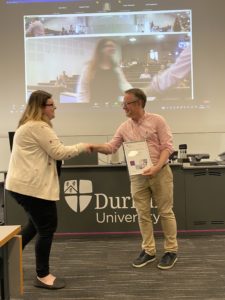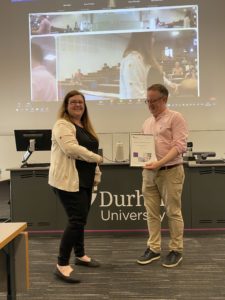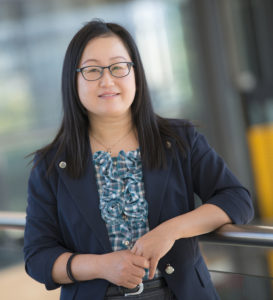We are pleased to share a selection of our referee-recommended HOT articles for January to June 2022. We hope you enjoy reading these articles, congratulations to all the authors whose articles are featured! As always, Chemical Science is free for authors and readers.
You can explore our full 2022 Chemical Science HOT Article Collection here!
Browse a selection of our January to June HOT articles below:
January:
Universal encoding of next generation DNA-encoded chemical libraries
Louise Plais, Alice Lessing, Michelle Keller, Adriano Martinelli, Sebastian Oehler, Gabriele Bassi, Dario Neri, and Jörg Scheuermann
Chem. Sci., 2022,13, 967-974
Solid-state 17O NMR study of α-d-glucose: exploring new frontiers in isotopic labeling, sensitivity enhancement, and NMR crystallography
Jiahui Shen, Victor Terskikh, Jochem Struppe, Alia Hassan, Martine Monette, Ivan Hung, Zhehong Gan, Andreas Brinkmann, and Gang Wu
Chem. Sci., 2022,13, 2591-2603
February:
Fluorescent supramolecular polymers of barbiturate dyes with thiophene-cored twisted π-system
Maika Kawaura, Takumi Aizawa, Sho Takahashi, Hiroshi Miyasaka, Hikaru Sotome, and Shiki Yagai
Chem. Sci., 2022,13, 1281-1287
Diboramacrocycles: reversible borole dimerisation–dissociation systems
Sonja Fuchs, Arumugam Jayaraman, Ivo Krummenacher, Laura Haley, Marta Baštovanović, Maximilian Fest, Krzysztof Radacki, Holger Helten and, Holger Braunschweig
Chem. Sci., 2022,13, 2932-2938
Stepwise assembly and reversible structural transformation of ligated titanium coated bismuth-oxo cores: shell morphology engineering for enhanced chemical fixation of CO2
Qing-Rong Ding, Yinghua Yu, Changsheng Cao, Jian Zhang, and Lei Zhang
Chem. Sci., 2022,13, 3395-3401
Photocytotoxicity and photoinduced phosphine ligand exchange in a Ru(ii) polypyridyl complex
Sean J. Steinke, Sayak Gupta, Eric J. Piechota, Curtis E. Moore, Jeremy K. Kondanko, and Claudia Turro
Chem. Sci., 2022,13, 1933-1945
March:
Catalytic asymmetric synthesis of enantioenriched α-deuterated pyrrolidine derivatives
Xin Chang, Xiang Cheng, and Chun-Jiang Wang
Chem. Sci., 2022,13, 4041-4049
Catalytic alkene skeletal modification for the construction of fluorinated tertiary stereocenters
Liyin Jiang, Pau Sarró, Wei Jie Teo, Jordi Llop, and Marcos G. Suero
Chem. Sci., 2022,13, 4327-4333
Chiral molecular nanosilicas
Zhaohui Zong, Aiyou Hao, Pengyao Xing, and Yanli Zhao
Chem. Sci., 2022,13, 4029-4040
Bioinspired superwettable electrodes towards electrochemical biosensing
Qinglin Zhu, Yuemeng Yang, Hongxiao Gao, Li-Ping Xu, and Shutao Wang
Chem. Sci., 2022,13, 5069-5084
Stronger together for in-cell translation: natural and unnatural base modified mRNA
Lisa Bornewasser, Christof Domnick, and Stephanie Kath-Schorr
Chem. Sci., 2022,13, 4753-4761
April:
Multi-component self-assembled molecular-electronic films: towards new high-performance thermoelectric systems
Troy L. R. Bennett, Majed Alshammari, Sophie Au-Yong, Ahmad Almutlg, Xintai Wang, Luke A. Wilkinson, Tim Albrecht, Samuel P. Jarvis, Lesley F. Cohen, Ali Ismael, Colin J. Lambert, Benjamin J. Robinson, and Nicholas J. Long
Chem. Sci., 2022,13, 5176-5185
Harnessing natural-product-inspired combinatorial chemistry and computation-guided synthesis to develop N-glycan modulators as anticancer agents
Wei-An Chen, Yu-Hsin Chen, Chiao-Yun Hsieh, Pi-Fang Hung, Chiao-Wen Chen, Chien-Hung Chen, Jung-Lee Lin, Ting-Jen R. Cheng, Tsui-Ling Hsu, Ying-Ta Wu, Chia-Ning Shen, and Wei-Chieh Cheng
Chem. Sci., 2022,13, 6233-6243
May:
Insights into electrochemiluminescence dynamics by synchronizing real-time electrical, luminescence, and mass spectrometric measurements
Xuemeng Zhang, Weifeng Lu, Cheng Ma, Tao Wang, Jun-Jie Zhu, Richard N. Zare, and Qianhao Min
Chem. Sci., 2022,13, 6244-6253
Cagearenes: synthesis, characterization, and application for programmed vapour release
Shuai Fang, Mengbin Wang, Yating Wu, Qing-Hui Guo, Errui Li, Hao Li, and Feihe Huang
Chem. Sci., 2022,13, 6254-6261

Submit to Chemical Science today! Check out our author guidelines for information on our article types or find out more about the advantages of publishing in a Royal Society of Chemistry journal.
Keep up to date with our latest articles, reviews, collections & more by following us on Twitter. You can also keep informed by signing up to our E-Alerts.


















